The Ultimate Guide to What is a Face-Off in Hockey?

Face-off is like a battle – ‘A Battle of Puck Possession.’ Face-off is the most crucial phase in the game where players fight to get the puck no matter what they have to do, not even afraid of getting kicked out at face-off.
Face-off takes place after a play stoppage. Usually, the other sports management, like soccer, and basketball, allows one team to take the ball after a play stoppage. Still, in the case of ice hockey, the scenario changes and turns into a battlefield because hockey officials do not give the puck to one specific team but instead throw a puck, leaving all onto the players who will get the puck.
Table of Contents
What Is A Face-Off?
Face-off is a way to start the game again after a game stoppage, like when a goal is scored, or there is a start of a period. At face-off time, players arrange themselves around the face-off circle, and one player (a center man) from each team stands head-to-head at the face-off spot and waits for the referee to drop the puck to begin the fight of the puck.
Times When Face-Off Takes Place
The number of occasions in ice hockey becomes the reason for play stoppage and causes a face-off. The primary cause of face-off occurrence are:
- Each time at the start of a new period, there will be a face-off to restart the game.
- The officials will grab the puck and throw it between opposing teams when a goal is scored.
- When the referee blows a whistle because of a penalty or some non-penalty cases like icing or offside.
- When the puck shot goes out of the rink.
Other instances that cause a face-off are:
- If a player gets injured and there is a game delay.
- If something unusual or out of the typical game happens, that is beyond the rule or complex to resolve.
- If a referee gets distracted and loses sight of the puck.
Areas Where Face-Off Takes Place Based On the Current Situation
On the ice arena, nine red face-off dots are located near the ice rink. NHL uses these dots to conduct the face-off to start or restart the game. But how to know which one of these spots will be used for a face-off?
Let’s have quick know-how of these face-off dots.
- Central ice dot: It is in the rick center and used at the start of the game or when there is a goal.
- Four dots on the blue line: These dots are in the neutral zone and are used to take face-off when there is an offside. That dot will be used for a face-off where there is an offside occurrence.
- Goalie closest four face-off dots: They are mostly used face-off dots. The prominent cases are:
- When the goaltender freezes the puck, a face-off will occur at the dot where the game is stopped.
- A face-off will be held in the penalized team zone when there is a penalty.
Strategy to Set Players in Face-Off
Centers are the ley for a face-off. Both team’s center men stand facing one another with a face-off dot between them. All the other players stand around the face-off circle. No one can stand inside the face-off dot, and wingers cannot stand beyond their side-specific marks.
The breakdown strategy: you must have wondered why all players do not stand near the face-off but rather far from the face-off circle.
The center tries to win the puck and get a chance for a quick shot direct on the net. So, the main job of the center is to direct the puck toward the defenseman standing away from the net so he has time to take the shot or find another player to give the puck to. So, for this, both team’s centers tie each other sticks up to give their winger a chance to get the puck and skates it to the defensemen.
The Two Centers – Who Will First Put Down His Stick?
When both team’s center men come forward for the face-off, one will put his stick down first, and who will be that center?
The visiting team’s center will put his stick down first, followed by the home team’s center. This is an advantage of being a home team because they get the time to observe the visiting center hand position.
- The home team has a chance to look at the visiting team’s center man setup and how he grips his stick – taking the sign of his way to winning the puck. The hand setting on the stick will either be forward or backward, indicating that a center wants to get the face-off. Observing all these settings allows the home’s center to adjust accordingly.
- After the stick putting down of the first center, the second center quickly gets into the game momentum, which the first center does not have much as he was standing static longer than him.
Players Switching In Face-Off
The only reason for players to switch in face-off is a violation. A Face-off violation is when a center or team player does something illegal that is out of the face-off procedure according to the NHL rule.
So, in consequence of a face-off violation, the violating team will have to substitute his center man with another player from their team. And this switching must be done immediately; otherwise, the linesman will drop the puck on time before they get ready.
If a team commits a violation twice in a row, they will come under a 2-minute penalty for the game delay.
What Causes A Face-Off Violation?
Many reasons cause a face-off violation.
- If a player other than the center moves into the face-off circle before the puck drop.
- If a touch other team’s player.
- If the center position does not match according to the face-off procedure.
- If the player’s skates are in the air and do not entirely on the ice.
In ice hockey, centers have the most winning percentage for a game, so losing a center can get against your team. That’s why every team keeps double players who are excellent in a face-off. The team with certain such players has more chances to win because they fearlessly take steps to win a face-off knowing they have a back-up. And at the end of the game, coaches pit two players who can replace the center in case of violation. But the original center is original!
How Can You Determine A Face-Off Win?
The face-off win determination depends on who has more time for puck possession, not on which team grabs the puck first. The other team can still get the puck back into their custody, and if they constantly have it, they can easily win the match.
In short, more time of puck possession equals more winning chances.
Is It Necessary For The Puck to Hit On The Ice At The Face-Off?
No, the puck does not need to hit the ice. Even if the puck is still in the air, the center can move into the circle and start the game. Once the referee drops the puck, the players can immediately engage themselves in the game without waiting for the puck to hit the ice.
However, it is pretty challenging to hit an airy puck, so most of the time, centers try to bring the puck down with their stick and then throw it toward their defensemen. Sometimes one center lifts the other center’s stick with his stick to get the puck on the ice, then skates it back in the direction of his defensemen.
Face-Off Winning Importance
Many have debated the topic of face-off winning importance recently. Some consider the correlation between face-off win percentages and a game-winning is not much.
By watching a game, you can see how many face-offs wins go against and how quickly a goal comes out of a face-off win within 1-2 minutes. So you can easily guess how important it is for a team to win a face-off.
Plus, teams focus on having more time for puck possession than the other team over the game, as it corresponds to the win. And we all know, what is the base to get the puck possession? The answer is to win a face-off.
Although face-off winning does not matter in short games, it dramatically influences big league games.
Face-Off Winning Percentages of A Team
Teams Face-off win percentage chart (FOW) 2021-22.
| Teams | Face-off Win Percentage |
| Toronto Maple Leafs | 55.1% |
| Dallas Stars | 54.8% |
| Boston Bruins | 54.2% |
| Caroline Hurricanes | 53.9% |
| Los Angeles Kings | 52.2% |
| Philadelphia Flyers | 52.1% |
| Vancouver Canucks | 52.0% |
| New York Islanders | 51.3% |
| Edmonton Oilers | 51.3% |
| Nashville Predators | 51.2% |
| Pittsburgh Penguin | 51.1% |
| Calgary Flames | 51.1% |
| Winnipeg Jets | 50.7% |
| St. Louis Blues | 50.2% |
| Tampa Bay Lightning | 50.1% |
| Chicago Blackhawks | 49.6% |
And if you check out all these 17 teams’ face-off winning percentage charts, only the first 12 succeed in making their way to the playoffs in the 2021-22 season. So, with this proof, the fact of face-off winning correlation with the game-winning becomes true. Along with the face-off win, a team gets more puck possession time, which leads the game in a pleasant direction.
Who Has The Best Face-Off Win Percentage?
Patrice Bergeron of the Boston Bruins has the best face-off (FOW) win percentage in the 2021-22 season, with more than 500 face-offs at 61.9%.
He has most of the face-off wins – 13,794. The Boston Bruins continuously ranked in the top five for the last three seasons, and the main reason for this ranking in this game area is Patrice Bergeron. He is a rank – 1 player of face-off wins—a star player of the Boston Bruins. Also, in a shorthanded face-off win, he lost only 34 shots which is far less than other shorthanded face-off wins.
Who is the NHL’s all-time favorite face-off player?
Yanic Perreault is one of the all-time favorite face-off leaders, and recently he was at 61.14% FOW of the December 2021 season. But Patrice Bergeron is considered the best face-off man in NHL history as he has the most face-off wins.
WE HAVE Answers
Frequently Asked Questions
The Bottom Line on What is a Face-Off in Hockey?
All this above discussion summarizes that winning a face-off will boost a team’s morale and more puck possession time, which most probably results in a game-winning. Hence, the teams and coaches put great attention and practice into face-off winning. Otherwise, it is also correct what players and coaches say that nothing much may happen from a face-off win, but if you have enough, it will affect the overall game course, eventually leading to a good ending.
Thanks!

Who is Austin Taylor?
Meet Austin Taylor, your go-to source for everything ice hockey! With a passion for the sport that’s as deep as the ice itself, Austin Taylor brings you concise, expert insights and nitty-gritty details on all things hockey. From gear reviews to strategy breakdowns, Austin Taylor is your trusted guide to navigating the exhilarating world of ice hockey. Get ready to lace up your skates and dive into the game with Austin Taylor as your ultimate companion.




